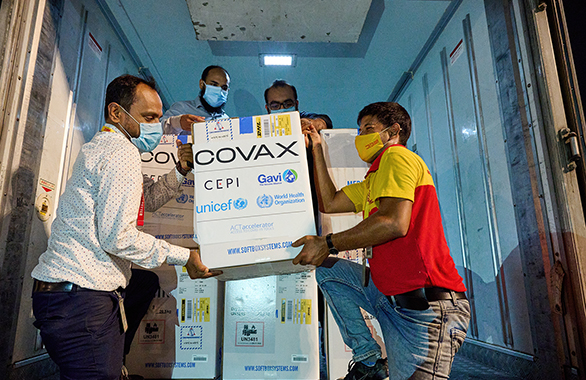
Bangladesh receives its first shipment of COVID-19 vaccines from the COVAX Facility led by directed by Gavi, CEPI, WHO and UNICEF on 31 May 2021.

Across the world, there are unacceptable disparities in access to Covid-19 vaccines, leaving many vulnerable people unprotected. This paper considers this challenge and sets out the action needed by G20 countries and vaccine manufacturers to rapidly increase global vaccination rates, with the aim of reaching 70% of the population in every country by June 2022.
Across the world, there are unacceptable disparities in access to Covid-19 vaccines, leaving many vulnerable people unprotected. This paper considers this challenge and sets out the action needed by G20 countries and vaccine manufacturers to rapidly increase global vaccination rates, with the aim of reaching 70% of the population in every country by June 2022.
This paper should be read alongside our policy paper on preparing for future pandemics, which considers the longer-term changes needed to pandemic preparedness and response.
What’s inside
- an overview of the status of the Covid-19 vaccine rollout and the key challenges driving vaccine inequity.
- recommendations for the G20 and vaccine manufacturers to tackle this inequity and help reach 40% vaccination coverage in all countries by the end of 2021 and 70% by June 2022.
Who this is for
- G20 governments
- vaccine manufacturers
- global health advocates.
The rollout of Covid-19 vaccines has been highly inequitable, with many more people in high-income countries receiving vaccinations than in low-income countries. If the vaccines delivered to date had been equitably distributed globally, all front-line health workers and vulnerable people would now be protected.
Between now and June 2022, we propose the following actions by G20 countries and vaccine manufacturers to ensure that supply is equitably distributed and is matched with critical support for delivery so that doses reach the arms of the people that need them most.
Redistribute existing supply
- G20 countries with high vaccination coverage should accelerate and increase dose donations to COVAX to ensure 40% coverage in every country by the end of 2021.
- G20 countries with high vaccination coverage should swap places with COVAX in vaccine supply queues so that manufacturers can fulfil existing COVAX agreements more quickly.
Equitably allocate future supply
- Vaccine manufacturers and G20 countries should allow COVAX first right of refusal on a significant proportion of new supply until the end of 2022, to avoid restricted supply going to the same group of wealthy nations.
- Vaccine manufacturers, supported by G20 countries, should facilitate increased production by offering or increasing comprehensive, non-exclusive licensing of intellectual property and technology transfers to additional manufacturers.
Support vaccine delivery
- G20 countries should support rapid mobilisation of easily accessed funds for Covid-19 vaccine delivery, including direct investment in the ACT Accelerator.

For more information, please contact Chloe Watson, Policy Adviser at C.Watson@wellcome.org.